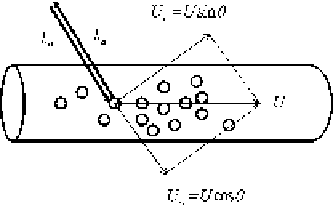Biomedical Engineering Reference
In-Depth Information
Fig. 5.16
Schematic for optical Doppler tomography. The sample arm beam is held at some angle
to the direction of flow. Therefore, an optical signal with wavevector k
0
falls on a particle moving
with velocity
u
. The light scattered back into the sample objective is Doppler shifted and has
wavevector k
d
the interferometer is scanned to match the path length within the capillary. At each
spatial point within the capillary, the detector intensity is sampled at a rate not less
than two samples per time period of the source. The time varying result is then
Fourier transformed to give the Doppler frequency shift due to moving particles
within the capillary. By doing this at a number of points within the capillary, a
profile of particle flow is determined.
The
axial resolution
of DOCT is again dependent on the source temporal
coherence length and the lateral scan resolution on the beam spot size. Velocity
resolution depends upon the detection electronics, scan angle, and the acquisition
time. Reported flow velocity resolutions are in the region 10-100 ms
1
;however,
recent developments in Fourier domain DOCT (FD-DOCT) have shown a velocity
resolution of just a few micrometers per second. FD-DOCT has also shown greater
sensitivity in the region of 90-115 dB and may, therefore, lend itself to ocular flow
imaging where ANSI laser safety standards require optical powers to be below
1 mW. DOCT has been applied to a number of medical situations. Not least of
these, imaging in vivo blood flow in both the skin [
117
] and retina [
110
] has been
demonstrated. The capability of DOCT to measure flow within a scattering sample
also has potential in new areas of research such as microfluidics [
118
].
5.6.3
Optical Microangiography
Optical microangiography
(OMAG) is a functional extension to FD-OCT imaging
modality capable of resolving 3D distribution of dynamic blood perfusion at the
capillary level within microcirculatory beds in vivo. Unlike Doppler OCT to image
blood flow, OMAG explores implicitly the phase information embedded in the
OCT spectral interferograms. By using heterodyne technology, OMAG method
effectively separates the scattering signals caused by the moving scatters, for

Search WWH ::

Custom Search